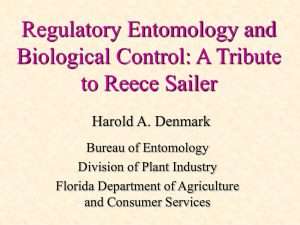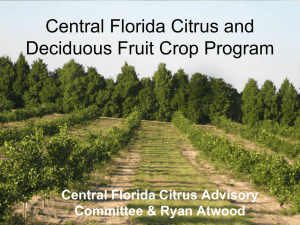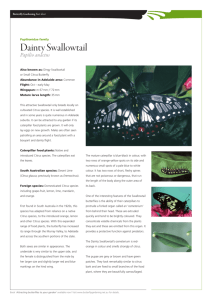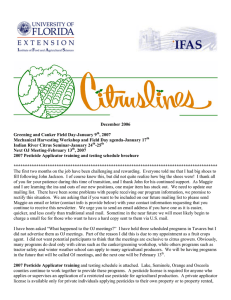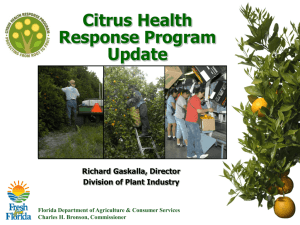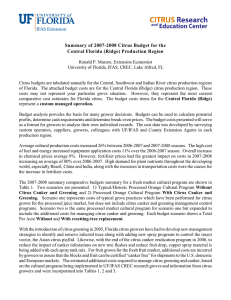C, P - Entomology and Nematology Department
advertisement
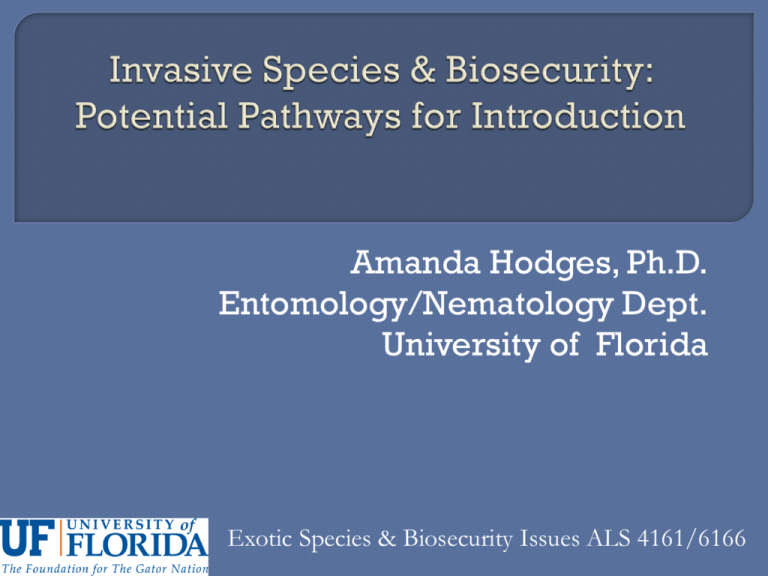
Amanda Hodges, Ph.D. Entomology/Nematology Dept. University of Florida Exotic Species & Biosecurity Issues ALS 4161/6166 Examine Case Study Examples Consider Invasive Species Pathways- Accidental v/s Purposeful Introduction Biosecurity Threat Potential? Barberry (Berberis) Salmonella outbreaks Zebra mussels Citrus greening in Florida Cherry Curry Foot vinegar fly in Florida in California and Mouth Disease More information available at: http://www.ars.usda.gov/Main/docs.htm?docid=10755 1984, 751 cases in the U.S. November 2008March 2009, 691 cases, 9 deaths U.S. states and Canada, peanuts More Information Available at: http://www.cdc.gov/salmonella/typhimurium/ 2008 Jalapeno and Serrano Peppers from Mexico 2010, Florida Senate passes food safety legislation for Florida tomatoes 1988, Lake St. Clair Within 10 years, all 5 Great Lakes, the Mississippi, Tennessee, Hudson, and Ohio River Basins infested One female: 1 million eggs/year Photo Credit: U.S. Geological Survey Archive http://www.invasive.org/ Image No. 1354035 U.S. Department of the Interior, U.S. Geological Survey, Distribution Map http://nas.er.usgs.gov/taxgroup/mollusks/zebramussel/zebramusseldistribution.aspx U.S. Fish and Wildlife Service estimates that this mussel will cost billions of dollars in the Great Lakes Region for the U.S. and Canada over the next 10 years Photo Credit: Pipe clogged with zebra mussels. Craig Czarnecki, Michigan Sea Grant http://www.invasive.org/ Image No. 5411907 Video: http://www.youtube.com/watch?v=-V5513w1XSk First Detection of Citrus Greening, Liberibacter asiaticus September 2005 Listed as a Select Agent until October 2008 Photo Credit: FDACS-DPI http://www.doacs.state.fl.us/press/2005/09022005_2.html http://www.selectagent.gov/resources/Biennial%20Review_APHIS_20081016.pdf The Vector, Asian Photo Credit: FDACS-DPI Citrus Psyllid, Diaphorina citri Arrived in Florida in 1998 Occurs on other ornamental hosts, including orange jasmine, Murraya paniculata “Citrus greening quarantine zone has been expanded to the entire state of Florida.” “Nursery - All citrus nursery stock that is produced or located within an established citrus greening quarantine area shall not be eligible for movement or distribution outside of the citrus greening quarantine area, except citrus nursery stock intended for export to foreign markets.” Source: FDACS-DPI Website, http://www.doacs.state.fl.us/pi/chrp/greening/cgmaps.html August 28, 2009 “Homeowners in Residential Areas - While the planting of certified citrus in a citrus greening quarantine area is allowed, the movement of citrus plant material outside of the quarantine area is prohibited.” Source: FDACS-DPI Website, http://www.doacs.state.fl.us/pi/chrp/gre ening/cgmaps.html August 28, 2009 Photography credit: University of California Cooperative Extension, Mariposa County Photography Credit: G. Arakelian, Los Angeles County Agricultural Commissioner/Weights & Measures Department Image at: http://www.pestalert.org/newsAlertDocs /Drosophila%20suzukii%20Bolda%209Ju ly09.pdf Arrived in California in 2008 Lays in pre-harvest fruit A potential threat to Florida’s strawberries, blueberries, and other fruit-based commodities. If you find maggots in fruit arriving from California, report and submit sample. Do not discard of remaining fruit in your yard. Double-bag and dispose in your household trash can. Photo Credit: Charles Haynes http://www.flickr.com/photos/haynes/2200901457/sizes/l/ July 2009 Trained Dog Detects curry leaves in FEDEX package shipped from India. Asian Citrus Psyllids were present. Later determined to be Citrus Greening (+) Image Available at: http://www.paajaka.com/2007/04/curry-leaves-kudhi-menusu.html Sacramento County sniff dog finds 100 Asian Citrus Psyllids this week! August 27, 2009 http://yubanet.com/c alifornia/Sniff-DogFinds-Asian-CitrusPsyllids-atSacramento-PackageFacility.php Beagle Makes News-http://www.youtube.com/watch?v=Tw-XaO0oT9o&feature=related http://www.aphis.usda.gov/import_export/animals/animal_import/ animal_imports_fmd.shtml Two day old ruptured vesicle (blister) on tongue, lower gum and lower lip of a steer Photo Credit: Australia Department of Agriculture, Fisheries, and Forestry http://www.daff.gov.au/animal-plant-health/pests-diseases-weeds/animal/fmd/pic-cattle FMD considered the “the most dangerous foreign disease that might be introduced accidentally…or as a terrorist threat”. Breeze (2004) Photo Credit: Australia Department of Agriculture, Fisheries, and Forestry http://www.daff.gov.au/animal-plant-health/pests-diseases-weeds/animal/fmd/pic-cattle 7 types of FMD virus and 70 subtypes Easily spread, including several miles by air ~20 times more infectious than smallpox Restrictions on carrying meat, cheese, and other meat-related products from infested regions of the world. Breeze, R. 2004. Agroterrorism: Betting Farm More than the Farm. Exotic Pests and Diseases: Biology and Economics for Biosecurity, Chapters 1-3, 5, 7 Florida Department of Agriculture, Division of Plant Industry (FDACS-DPI) Citrus Health Response Program website http://www.doacs.state.fl.us/pi/chrp/greening/citrusgreening.ht ml USDA Zebra Mussel Informational Links http://www.invasivespeciesinfo.gov/aquatics/zebramussel.shtml Lodge, D.M., M.A. Lewis, J.F. Shogren, and R.P. Keller. 2009. Introduction to Biological Invasions: Biological, Economic, and Social Perspectives. In: Bioeconomics of Invasive Species: Integrating Ecology, Economics, Policy, and Management. Keller, R.P., D.M. Lodge, M.A. Lewis, J.F. Sogren. Pp. 1-24. Oxford University Press. ALS 4161 and 6166 Exotic Pests and Diseases: Biology and Economics for Biosecurity, Chapters 1-3 (pages 1-33), Chapter 5 (pages 55-67) ALS 6166 Only Border Enforcement and Firm Response in the Management of Invasive Species Federal Document on Agroterrorism Which of the pests and pathogens discussed would the public perceive as the most devastating? Why? Which of the pests and pathogens listed has the greatest longterm economic impact potential? Would you consider all of the pests and pathogens discussed a biosecurity threat? Why?
